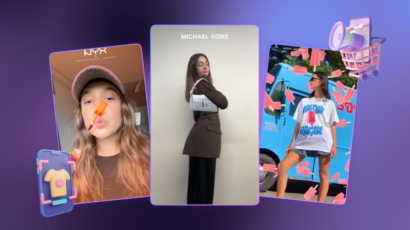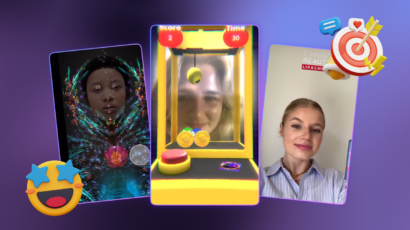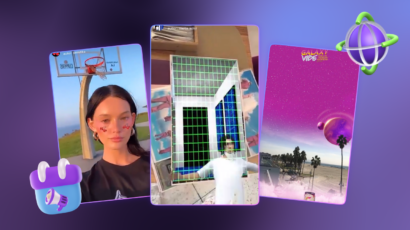Attention length are shorter than ever. Nowadays, catching the eye of Gen Z has become the huge challenge for marketing managers. The early 2000s showed that millennials’ attention span tapped out at 12 seconds, while for Generation Z, the number is even lower at 8 seconds. Well, they do not have much time to watch you, but ironically, they do have a higher ad recall rate.
Gen Z is the first generation of consumers to grow up with complete access to the internet. This has completely transformed the way they interact with brands and make purchasing decisions, making it critical for businesses to understand their unique needs and preferences.
To do this, marketers need to find new ways to engage Gen Z users, find new strategies that offer a personalized experience that drives results and meet the demand for immersive experiences from a new generation of digital natives.
One and the best way to accomplish this is through augmented reality (AR). Because it is intrinsically personal, AR puts the user at the center of a story and makes them an active participant with branded content. By doing this, AR allows brands to create meaningful connections with consumers. And with web-based augmented reality (WebAR), brands can power AR everywhere through the browser, with no app download required. In this blog post, we’ll explore the challenges of reaching Gen Z and how AR can bridge the gap between traditional marketing and Gen Z’s desire for engaging experiences.
Do you understand Gen Z?
Traditional marketing methods are becoming less effective at engaging Gen Z consumers. Neuroscientific researcher Neuro-Insight found that AR experiences deliver almost double the levels of engagement of non-AR interactions.
- According to a report from Accenture, 50% of consumers better recall brands that engage them with immersive technologies, and 47% say immersive technologies make them feel more connected with products.
Gen Z, the digital natives of today, have distinct digital habits.
- They prefer short-form content, making platforms like TikTok their playground.
- Social media is their domain, dominating platforms with their creativity.
- What matters most to them is authenticity; they can spot a phony from miles away.
Tech-savvy and open to new experiences, they’re the ones shaping the future of the digital world.
Change rules of games with AR:
As the purchasing power of Gen Z grows, so does their demand for innovative online experiences.
According to a 2021 Consumer AR Global Report by Snap, when users interact with products featuring AR experiences, it leads to a 94% higher conversion rate. This is because consumers can better assess products and form a deeper connection with brands.
AR aligns with Gen Z’s desire for more engaging content than static ads. For example, you can try on clothes virtually, visualize furniture placement in a room, or experience interactive product demos. AR creates exciting and dynamic encounters that appeal to the younger generation’s thirst for innovation and interactivity.
AR campaigns can help agencies achieve their client’s goals effectively by:
- Increasing brand awareness through shareable and interactive experiences.
- Improving brand loyalty by fostering deeper connections with Gen Z.
- Driving sales by allowing Gen Z to virtually interact with products.
How brand can entertain Gen Z
One of the successful examples is an AR virtual try-on experience created for Chilli Beans, the largest eyewear store in Latin America. This AR experience featured over 1,000 3D eyewear models for seven Chilli Beans Special Collections. Gen Z customers could access the WebAR try-on experience on the Chilli Beans website.
Once activated, customers could see themselves wearing virtual replicas of the sunglasses, resulting in a 48% increase in sales of sunglasses that relied on the virtual try-on experience. This innovative use of AR demonstrates how brands can help Gen Z customers make informed decisions when shopping online, particularly given the economic climate they’ve grown up in.
Actionable Steps for Agencies:
Here’s a simplified roadmap for agencies to implement AR into their marketing strategies:
- Identify client needs and target audience:
- Analyze the client’s brand, products, and objectives.
- Define the target audience, focusing on Gen Z preferences.
- Determine suitable AR experiences based on the target audience and goals.
- Partner with AR development companies:
- Research and select reputable AR development companies.
- Collaborate closely to ensure the AR experience aligns with the brand and objectives.
- Design and implement engaging AR experiences.
- Measure campaign success through relevant metrics:
- Establish KPIs tailored to the campaign’s objectives.
- Use analytics tools to track engagement, reach, and conversions.
Analyze performance data to optimize the AR campaign and maximize results.
To sum up, AR is a powerful tool for reaching Gen Z, offering immersive and engaging experiences. By integrating AR into their campaigns, agencies can stay relevant and connect with the next generation of consumers. AR is a future-proof marketing tool that offers endless possibilities. Fear not, book a call now to get ideas how to drive meaningful engagement with Gen Z consumers







